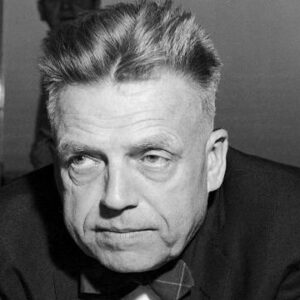Alfred Charles Kinsey was an American professor, biologist, and sexologist credited with initiating the “Sexual Revolution” through his extensive research on human sexuality. He was a courageous and outspoken researcher who was not afraid to study taboo subjects or to incite controversy with his findings. He began his career as a biologist with an interest in gall wasps. He wrote his doctoral dissertation on the species, titled ‘The Gall Wasp Genus Cynips: A Study of Species Origins’. Despite his expertise in this field, he felt that prestigious positions eluded him, altering the trajectory of his career. His interest in human sexuality stems from his research on gall wasp mating behavior as well as his own sexual feelings and experiences. He began his research on human sexuality in the 1930s, a period when conservative American society regarded sex as a taboo subject. He was unfazed by the public outcry, however, and conducted thousands of interviews to gather data for his studies. When he published his findings in a book, the entire nation, particularly the religious community, was taken aback. Additionally, he sparked controversy with his open marriage and sexual relations with other men.
Childhood & Adolescence
He was born in Hoboken, New Jersey on 23 June 1894. He was the eldest of Alfred Seguine Kinsey and Sarah Ann’s three children. His father, a professor at Stevens Institute of Technology, was an extremely religious and strict man.
Alfred suffered from a variety of medical conditions as a child, and his impoverished parents were unable to provide him with adequate treatment. He had rickets, which resulted in a curvature of the spine.
He was fascinated by nature from an early age and particularly enjoyed camping. He joined the Boy Scouts with the encouragement of his parents and earned the rank of Eagle Scout in 1913, making him one of the earliest Eagle Scouts.
He attended Columbia High School and excelled academically while also being an accomplished pianist. He developed a strong interest in botany, biology, and zoology and chose to major in botany in college, much to his father’s chagrin.
Alfred reluctantly agreed when his authoritative father ordered him to study engineering at Stevens Institute of Technology. However, he was unable to continue studying engineering for an extended period of time and dropped out after two years.
He enrolled at Bowdoin College in Maine in 1914 and majored in entomology. He was elected to the Phi Beta Kappa society in 1916 and earned degrees in biology and psychology magna cum laude.
He continued his studies at Harvard University’s Bussey Institute. He studied biology there under William Morton Wheeler, an entomologist.
Alfred completed his doctoral dissertation on gall wasps. He traveled extensively and sampled thousands of specimens. In 1919, he earned his Sc. D degree.
Career of Alfred Kinsey
In 1920, he was appointed assistant professor at Indiana University. In 1926, he published ‘An Introduction to Biology,’ a biology textbook in which he unified the previously distinct fields of zoology and botany.
In 1929, he was promoted to full professorship. During the 1930s, he published ‘The Gall Wasp Genus Cynips: A Study of Species Origin’ and ‘The Origin of Higher Categories in Cynips’. However, he was beginning to lose faith in his career at the time.
He was offered the opportunity to direct a team-taught course on marriage and family in 1938. He delivered lectures on the biology of sexual stimulation, intercourse mechanics, and contraception. His course quickly gained popularity.
In 1947, he founded the Kinsey Institute for Research in Sex, Gender, and Reproduction at Indiana University as a nonprofit research institute. The Institute’s mission was to promote sexual health and sexual research. This institute’s establishment was also fraught with controversy.
In January 1948, he published ‘Sexual Behavior in the Human Male.’ It immediately became a best-seller upon its release, despite the fact that it was an extremely thick volume with 804 pages. Religious leaders were incensed by the book’s sexual content.
He published ‘Sexual Behavior in the Human Female’ in 1953, which sparked even more controversy than its predecessor. Nearly 6000 sexual histories were compiled for the book.
Significant Work of Alfred Kinsey
He is best known for the Kinsey Reports, which are comprised of two books on human sexual behavior: ‘Sexual Behavior in the Human Male’ (1948) and ‘Sexual Behavior in the Human Female’ (1949). (1953). Although the reports were extremely popular, they also sparked considerable controversy due to the taboo surrounding the subject of sex.
Awards and Accomplishments
In 2012, he was inducted into the Legacy Walk, an outdoor museum walk dedicated to LGBT history and culture.
Personal History and Legacies
In 1921, he married Clara Bracken McMillen. His estranged father declined to attend. The couple’s firstborn died as a child; their other three children survived to adulthood.
He identified as bisexual. His marriage to Clara was an open one, which meant that both parties were free to engage in sexual relations with other people.
He fell ill in his later years and died on 25 August 1956, aged 62.
Estimated Net Worth
Alfred is a wealthy Psychologist who is listed on the most popular Psychologist list. Alfred Kinsey’s net worth is estimated to be around $1.5 million, based on our analysis of Wikipedia, Forbes, and Business Insider.


